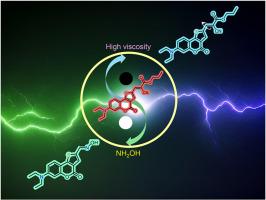双功能荧光探针用于检测活细胞和斑马鱼的羟胺和黏度
IF 4.2
3区 工程技术
Q2 CHEMISTRY, APPLIED
引用次数: 0
摘要
羟胺在生物过程中至关重要,是细胞代谢的重要副产物,也是l-精氨酸转化为一氧化氮(NO)和硝基(HNO)的重要中间体。本研究提出了一种新型荧光探针CSO-CY的设计和合成,CSO-CY是由刚性平面噻吩香豆素荧光团通过碳碳双键连接到氰乙酸酯部分构成的。探针与羟胺相互作用,在羟胺检测过程中产生肟衍生物,导致荧光强度在653nm处降低,在490nm处增强。此外,在高粘度环境中,466 nm处的荧光强度逐渐上升。总的来说,CSO-CY在广泛的pH范围(6-11)的PBS缓冲液中表现出显著的选择性,快速的响应时间(25 s)和显著的灵敏度(检测限:142 nM),以感应羟胺,使其非常适合复杂的生理条件。该探针已被有效地用于活细胞和斑马鱼体内羟胺的检测。这些发现表明,CSO-CY是一种很有前途的化学传感器,用于监测生物系统中羟胺的动力学和粘度,强调了其相当大的实用潜力。本文章由计算机程序翻译,如有差异,请以英文原文为准。

Dual-functional fluorescence probe for detecting hydroxylamine and viscosity in living cells and zebrafish
Hydroxylamine is vital in biological processes, acting as a significant byproduct of cellular metabolism and a crucial intermediate in the transformation of l-arginine to nitric oxide (NO) and nitroxyl (HNO). This study presents the design and synthesis of a novel fluorescent probe, CSO-CY, which is constructed from a rigid planar thienocoumarin fluorophore connected to a cyanoacetate moiety through a carbon–carbon double bond. The probe interacts with hydroxylamine to produce an oxime derivative during hydroxylamine detection, leading to a reduction in fluorescence intensity at 653 nm and an enhancement at 490 nm. Moreover, fluorescence intensity at 466 nm incrementally rises in high-viscosity environments. Overall, CSO-CY demonstrates significant selectivity, a fast response time (25 s), and remarkable sensitivity (detection limit: 142 nM) in PBS buffer across an extensive pH range (6–11) towards sensing hydroxylamine, rendering it highly appropriate for intricate physiological conditions. The probe has been effectively utilized for the detection of hydroxylamine in living cells and zebrafish. These findings indicate that CSO-CY is a promising chemosensor for monitoring hydroxylamine dynamics and viscosity in biological systems, underscoring its considerable practical potential.
求助全文
通过发布文献求助,成功后即可免费获取论文全文。
去求助
来源期刊

Dyes and Pigments
工程技术-材料科学:纺织
CiteScore
8.20
自引率
13.30%
发文量
933
审稿时长
33 days
期刊介绍:
Dyes and Pigments covers the scientific and technical aspects of the chemistry and physics of dyes, pigments and their intermediates. Emphasis is placed on the properties of the colouring matters themselves rather than on their applications or the system in which they may be applied.
Thus the journal accepts research and review papers on the synthesis of dyes, pigments and intermediates, their physical or chemical properties, e.g. spectroscopic, surface, solution or solid state characteristics, the physical aspects of their preparation, e.g. precipitation, nucleation and growth, crystal formation, liquid crystalline characteristics, their photochemical, ecological or biological properties and the relationship between colour and chemical constitution. However, papers are considered which deal with the more fundamental aspects of colourant application and of the interactions of colourants with substrates or media.
The journal will interest a wide variety of workers in a range of disciplines whose work involves dyes, pigments and their intermediates, and provides a platform for investigators with common interests but diverse fields of activity such as cosmetics, reprographics, dye and pigment synthesis, medical research, polymers, etc.
 求助内容:
求助内容: 应助结果提醒方式:
应助结果提醒方式:


